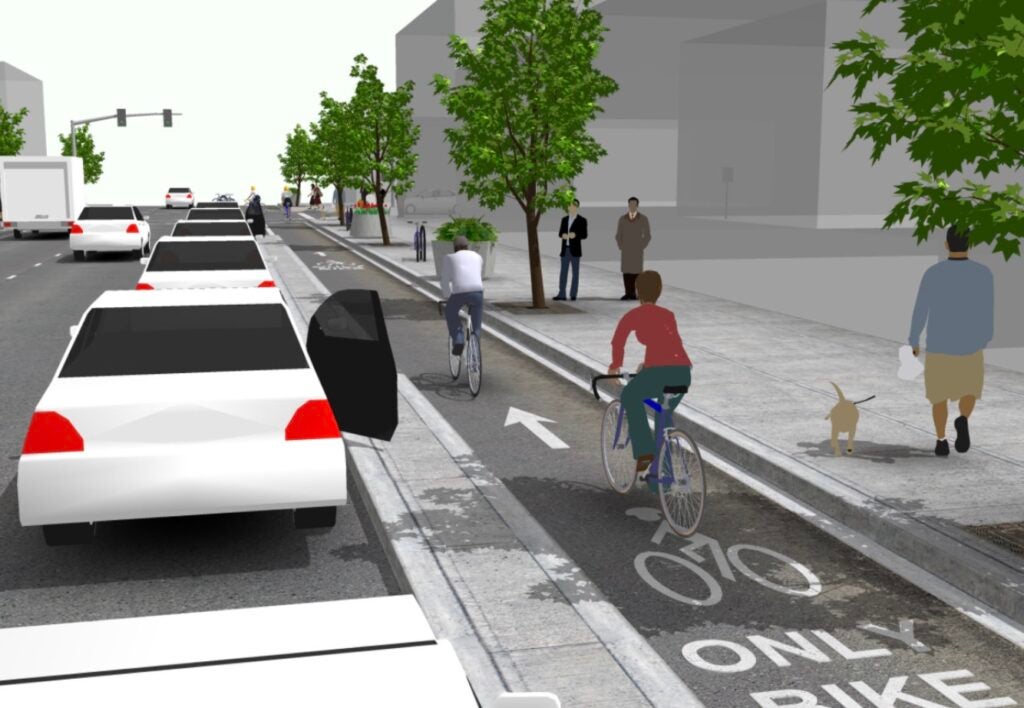After years of planning, Augusta’s Broad Street overhaul is moving forward. The latest revised plan adds more parking spaces than first proposed while keeping bike lanes in place.
The changes are part of an approximately $45 million project funded by the regional 1% Transportation Investment Act sales tax, phases 1 and 2. Work will progress block by block and eventually span the length of Broad, from Washington Road to East Boundary.
Initial concepts first presented to the public in 2016 removed the sunken parking wells designed by architect I.M. Pei in the 1970s, but left 700-800 street-level parking spaces intact.
But current plans must follow state mandates and accommodate today’s larger trucks and SUVs, according to Augusta Traffic Engineer John Ussery. Simply enlarging existing spaces reduced the parking count from 760 to 620 spaces, Ussery said.
Final concepts incorporated numerous greenspace and streetscape features. These included a James Brown linear park spanning the median of the 800 block.
Plan revised to restore 160 spaces
The resulting plan reduced available parking from 620 spaces to 430. As construction got underway, the numbers didn’t sit well with downtown merchants. After their feedback, engineers were able to add back 160 spots, bringing the new total to 590, Ussery said.
“We’re not losing gobs of parking. We’re losing about 30 usable spots,” he said.
Engineers made room for the 160 spaces by altering the design of all blocks from 500 to 1300 except for the linear park. In particular, they added “a lot of additional spaces” in the 500, 1100 and 1200 blocks, Ussery said.
The revision “maintained the character of the rebuild.” It removed or made smaller several landscaped areas, but still contains more landscape and decorative elements than today, he said.
Plans approved by the Augusta Commission in 2018 included parallel and angle parking as well as wide sidewalks, part of which are bike lanes, Ussery said.

Five feet dedicated to bikes
Current plans show five feet of the sidewalk on both sides of Broad from 15th Street to East Boundary as a raised bicycle lane. The bike lane will be separated from the pedestrian lane, Ussery said.
Under state-adopted “Complete Streets” criteria, the new roadway must accommodate modes of transportation in addition to passenger vehicles, he said. These are pedestrian, bicycle and public transit.
While TIA funding is generated regionally, the tax program is a state-controlled process with its projects subject to state oversight and management, if need be, he said.
The bike lanes can potentially serve double duty during special events as added public space for pedestrians or vendors, Ussery said.
The lanes will form a connected loop that ties in with the Freedom Bridge, the Riverwalk and bike lanes on Fifth, Telfair and 12th streets, he said.
Vendors: Don’t reduce car parking for bicycles
A Change.org petition started earlier this month by Luigi’s restaurant owner Penelope Ballas-Stewart argues to retain on-street parking on Broad, particularly on behalf of its limited-mobility patrons.
The petition says Augusta is “shifting its focus from car parking to bicycle lanes,” which “does not align with the current needs of our community.”
As of Saturday, the petition had 1,672 verified signatures. Those submitting them had addresses spanning an area from Murphy Estates to Hephzibah to Harlem.

Ussery: Too late to go back
While repainting parking spaces is relatively inexpensive, redesigning the streetscape to remove the bike lanes would be costly, Ussery said.
“It would be very expensive to remove them because basically you’re narrowing the sidewalk,” he said. “All of the civil engineering part of this would have to be redesigned.”
That would include storm drain profiles, underground piping, water and sewer, electricity and street lighting laid out in the project’s some 300-400 pages of plans, he said.
Other parking options
Additional downtown parking options include four little-used nearby parking decks as well as potential plans to paint new spaces on two nearby roads, according to Ussery.
On Reynolds Street, which parallels Broad a block north, a “road diet” could reduce lanes from four to two. In the freed space, some 400 parking spots could be painted in from the 500 to 1200 blocks, he said.
In addition, the conversion of Ellis Street a block south of Broad to a one-way street could add an additional 90 spots.
While further away than on-street parking on Broad, four parking decks provide parking within a five-minute walk, although some charge a fee or have time restrictions.
- Augusta Convention Center Parking Deck, 918 Reynolds St. Average lunchtime usage is 91 spaces or 15% full.
- Cyber Center Parking Deck, 9 11th St. Average usage 245 or 31% full.
- Truist Parking Deck, 648 Reynolds St. Average usage 70, 28% full.
- Board of Education Deck, 846 Ellis St. Average usage 287, available weekdays after 5 p.m. and weekends.
The Augusta Commission debated the installation of a paid parking system on Broad with a two-hour limit prior to the onset of the pandemic.
Today parking is unrestricted or spaces are designated to have a two-hour limit that is rarely enforced.
Ussery said parking needs to be managed to maximize its availability. Currently many take up available on-street parking for employee parking, vehicle storage, loading and unloading, he said.
Timeline
The Broad Street project contract is for 1,260 working days, or about three-and-a-half years. Work is underway between 13th and 15th streets now and expected complete in early fall, according to Ussery.
Pre-construction work including tree removal began last month at 13th and was expected to progress by block east to the Gordon Highway overpass.
Construction of the James Brown linear park between Eighth Street and James Brown Boulevard is scheduled to begin in June.












